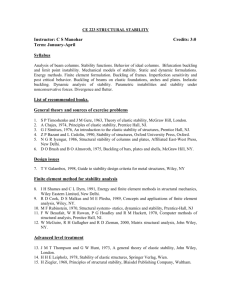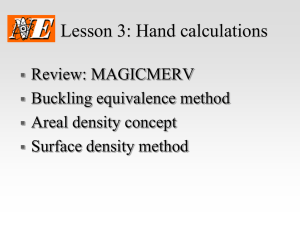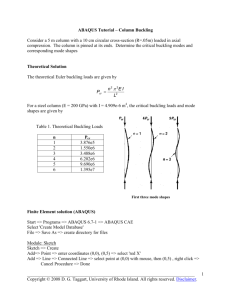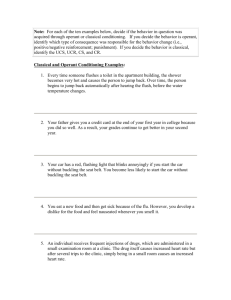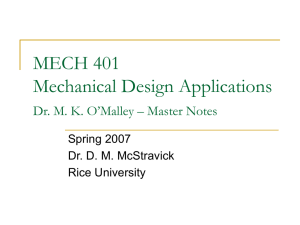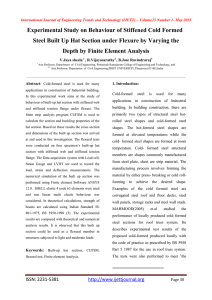Coming Soon A Simpler, Faster, Cold-Formed Steel Design (The Direct Strength Method)
advertisement
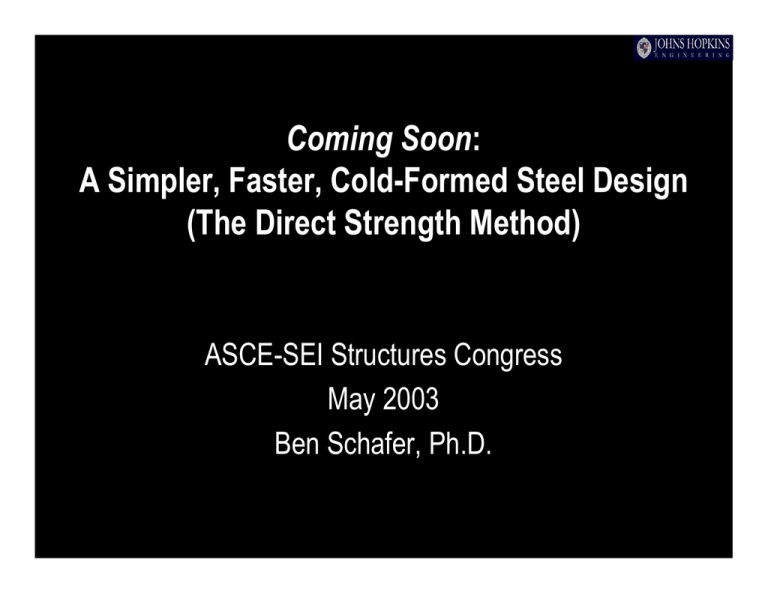
Coming Soon: A Simpler, Faster, Cold-Formed Steel Design (The Direct Strength Method) ASCE-SEI Structures Congress May 2003 Ben Schafer, Ph.D. Specification complication • “Anyone who has ever attempted to design a light-gage member following the Specification provisions probably realized how tedious and complex the process was.” • “When such [cold-formed] framing is needed one of two things tend to happen to the engineers: they either uncritically rely on the suppliers’ literature, or simply avoid any cold-formed design at all…” Alexander Newman 1997, in Metal Building Systems Rinchen (1998) - Australia Kesti (2000) - Finland Landolfo and Mazzolani (1990) - Italy Specification complication explained • Sections are not doubly-symmetric • Element elastic buckling calculation (k’s) • Effective width – effective width = f(stress,geometry) – stress = f(effective properties: e.g., Aeff, Ieff) – iteration results • Web crippling calculations • Inclusion of system effects Specification complication explained • Sections are not doubly-symmetric Mechanics / elastic buckling • Element elastic buckling calculation (k’s) • Effective width – effective width = f(stress,geometry) Direct strength curves – stress = f(effective properties: e.g., Aeff, Ieff) – iteration results • Web crippling calculations • Inclusion of system effects www.ce.jhu.edu/bschafer/cufsm finite strip resource My=192 kip-in. Local buckling Distortional Lateral-torsional Direct strength prediction Pn = f (Py, Pcre, Pcrd, Pcrl)? • Input – – – – Squash load, Py Euler buckling load, Pcre Distortional buckling load, Pcrd Local buckling load, Pcrl • Output – Strength, Pn Elastic buckling Elastic buckling Direct Strength Curve (university of sydney testing) 1 channel rack rack+lip hat channel+ web st. strength (Fu/F y) or (Pu /Py ) 0.8 0.6 (a) (b) (c) (d) (e) 0.4 0.2 0 0 0.5 1 1.5 2 2.5 3 3.5 .5 4 .5 distortional slenderness (Fy /Fcr) or (Py /Pcr) 4.5 5 Effective width and direct strength Columns • • • • • Lipped channels Lipped zeds Lipped channels with intermediate web stiffener Hat sections Rack post sections Kwon and Hancock (1992), Lau and Hancock (1987), Loughlan (1979), Miller and Peköz (1994), Mulligan (1983), Polyzois et al. (1993), Thomasson (1978) 267 columns , β = 2.5, φ = 0.84 Pn=min(Pne,Pnl,Pnd) Beams • Lipped and plain channels • Lipped zeds • Hats with and without intermediate stiffener(s) in the flange • Trapezoidal decks with and without intermediate stiffener(s) in the web and the flange Cees and Zeds: Cohen 1987, Ellifritt et al. 1997, LaBoube and Yu 1978, Moreyara 1993, Phung and Yu 1978, Rogers 1995, Schardt and Schrade 1982, Schuster 1992, Shan 1994, Willis and Wallace 1990 Hats and Decks: Acharya 1997, Bernard 1993, Desmond 1977, Höglund 1980, König 1978, Papazian et al. 1994 569 beams, β=2.5, φ=0.9 Direct strength advocacy • • • • • • No effective width, no elements, no iteration Gross properties Element interaction Distortional buckling Wider applicability and scope Encourage cross-section optimization Your computer performs analysis that employs fundamental mechanics instead of just mimicking old hand calculations. DSM integrates known behavior into a straightforward design procedure. provided examples Plenty of future research needed • • • • • • • • • • beam-columns and eccentric loads, isolated and patterned perforations, laterally un-braced flexural members, significant neutral axis shift in the post-buckling regime, geometric limitations and definition of applicability, fine-tuning and further calibration of strength expressions, interaction of distortional buckling with other modes, shear and shear interaction issues, calibration of new cross-sections, and elastic distortional buckling of all cross-sections. Concluding thoughts • DSM represents an opportunity for a new direction in cold-formed steel design. • By taking advantage of simple, yet fundamental, mechanics solutions (member elastic buckling via finite strip) we have the means to vastly simplify and at the same time improve design. • DSM can be used now for unusual sections via the rational analayis clause in AISI, and will be adopted as an alternative design procedure in the next Specification. Resources • Research www.ce.jhu.edu/bschafer • Finite strip www.ce.jhu.edu/bschafer/cufsm • Direct Strength www.ce.jhu.edu/bschafer/direct_strength LGSI Z12-25-14g How does Direct Strength work? • ELASTIC BUCKLING – You must determine all relevant elastic buckling values for your section, e.g., for a column the local, distortional, and flexural-torsional buckling loads. • DIRECT STRENGTH CURVES – Given the elastic buckling loads and the yield load empirical expressions (e.g., SSRC column curves) are used to predict the capacity. How does Direct Strength work? • ELASTIC BUCKLING – You must determine all relevant elastic buckling values forFinite your section, for a column the local, Strip e.g., (CUFSM) distortional, and flexural-torsional buckling loads. • DIRECT STRENGTH CURVES – Given the elastic buckling loads and the yield load empirical expressions (e.g., SSRC column curves) are used to predict the capacity.



